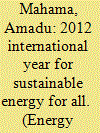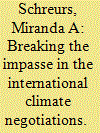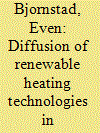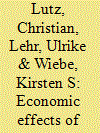|
|
|
Sort Order |
|
|
|
Items / Page
|
|
|
|
|
|
|
| Srl | Item |
| 1 |
ID:
115109


|
|
|
|
|
| Publication |
2012.
|
| Summary/Abstract |
2012 has been declared the "International Year for Sustainable Energy for All" by the UN. While Africa remains the most 'underpowered' continent, the prognosis for a brighter future is looking good, as key stakeholders (governments, private sector, civil society, and the donor community) have mobilized at an unprecedented scale to experiment with new policies, regulatory frameworks, and business models to rapidly upscale access to sustainable energy. The top-down, central grid expansion approach to increasing electricity access is very capital intensive and yet has gained considerable momentum at the expense of lower cost options that utilize decentralized off-grid solutions. A decentralized bottom-up approach could also use indigenous renewable energy sources and foster more significant linkages with livelihood opportunities in the rural un-served territories. This paper evaluates the emerging experiments through the lenses of C.K. Prahalad's "bottom of the pyramid" theory and Clayton Christensen's "disruptive technologies" perspective. Three front-runner initiatives involving new business models, innovative technologies, and institutional capacity building will be analyzed. In addition, the paper examines a regulatory policy initiative designed to stimulate clean energy investments in Ghana. Though the examples are all from Ghana, they illustrate general challenges to sub-Saharan Africa as a whole.
|
|
|
|
|
|
|
|
|
|
|
|
|
|
|
|
| 2 |
ID:
115157


|
|
|
|
|
| Publication |
2012.
|
| Summary/Abstract |
Two commercial wind turbines namely AN Bonus 300 kW/33 and AN Bonus 1 MW/54 were technically assessed for electricity generation in six selected high altitude sites spreading across the North-West and North-East geopolitical regions of Nigeria by computing their capacity factors, annual power and energy outputs. The economic evaluation of using the two wind energy conversion systems (medium and large) for electric power generation in the selected locations were also estimated using the present value cost method. The results showed that capacity factors of the two turbines in the selected sites ranged between 4.6 and 43%. Average minimum cost per kW h was obtained in Kano as $0.0222/kW h with AN Bonus 1 MW while the highest average cost is $0.2074/kW h with AN Bonus 300 kW in Kaduna. The highest cost in each of the location was obtained with the medium WECs (AN Bonus 300 kW). In addition, Kano and Katsina were also found to be very economical for any of the adopted wind turbine models. Gusau and Kaduna, at cost of unit energy of about $0.30/kW h were found to be more profitable for non-connected electrical and mechanical applications (water pumping, battery charging) than diesel generator.
|
|
|
|
|
|
|
|
|
|
|
|
|
|
|
|
| 3 |
ID:
115139


|
|
|
|
|
| Publication |
2012.
|
| Summary/Abstract |
There is a global resurgence in solar thermal power across the world. This paper provides a transparent framework for calculating the cost of generated electricity from a concentrated solar power (CSP) plant and the internal rate of return on equity. The different factors contributing to the capital cost and generation cost of CSP technology have been discussed. The effect of variation of plant size, solar insolation and discount rate has been shown. India has launched the Jawaharlal Nehru National Solar Mission (JNNSM) and plans to install 20 GW of grid connected solar power by 2022. An analysis of the bids received in the National Thermal Power Corporation's Vidyut Vyapar Nigam Ltd. (NVVN) bidding process, indicates that successful companies have access to low interest capital (effective discount rate ranging from 6.3-12.2%). With the current generation cost of 11-12 Rs/kW h (24-25 US Cents/kW h), an achievable target for CSP in the future is likely to be 6.5-7 Rs/kW h (14-15 US Cents/kW h). This may be possible through reductions in solar field and power block costs combined with increases in collector and overall plant efficiency.
|
|
|
|
|
|
|
|
|
|
|
|
|
|
|
|
| 4 |
ID:
115128


|
|
|
|
|
| Publication |
2012.
|
| Summary/Abstract |
Electricity demand forecasting could prove to be a useful policy tool for decision-makers; thus, accurate forecasting of electricity demand is valuable in allowing both power generators and consumers to make their plans. Although a seasonal ARIMA model is widely used in electricity demand analysis and is a high-precision approach for seasonal data forecasting, errors are unavoidable in the forecasting process. Consequently, a significant research goal is to further improve forecasting precision. To help people in the electricity sectors make more sensible decisions, this study proposes residual modification models to improve the precision of seasonal ARIMA for electricity demand forecasting. In this study, PSO optimal Fourier method, seasonal ARIMA model and combined models of PSO optimal Fourier method with seasonal ARIMA are applied in the Northwest electricity grid of China to correct the forecasting results of seasonal ARIMA. The modification models forecasting of the electricity demand appears to be more workable than that of the single seasonal ARIMA. The results indicate that the prediction accuracy of the three residual modification models is higher than the single seasonal ARIMA model and that the combined model is the most satisfactory of the three models.
|
|
|
|
|
|
|
|
|
|
|
|
|
|
|
|
| 5 |
ID:
115140


|
|
|
|
|
| Publication |
2012.
|
| Summary/Abstract |
The penetration of wind and solar generating resources is expected to dramatically increase in the United States over the coming years. It is widely understood that large scale deployment of these types of renewable energy sources (e.g., wind, solar) that have variable and less predictable production characteristics than traditional thermal resources poses integration challenges for bulk power system operators. At present, bulk power system operators primarily utilize strategies that rely on existing thermal generation resources and improved wind and solar energy production forecasts to manage this uncertainty; a host of additional options are also envisioned for the near future including demand response (DR). There are well-established bodies of research that examine variable generation integration issues as well as demand response potential; but, the existing literature that provides a comparative assessment of the two neither treats this topic comprehensively nor in a highly integrated fashion. Thus, this paper seeks to address these missing pieces by considering the full range of opportunities and challenges for mass market DR rates and programs to support integration of variable renewable generation.
|
|
|
|
|
|
|
|
|
|
|
|
|
|
|
|
| 6 |
ID:
115171


|
|
|
|
|
| Publication |
2012.
|
| Summary/Abstract |
Electric Vehicles (EVs) are promoted as a viable near-term vehicle technology to reduce dependence on fossil fuels and resulting greenhouse gas (GHG) emissions associated with conventional vehicles (CVs). In spite of the benefits of EVs, several obstacles need to be overcome before EVs will be widely adopted. A major barrier is that consumers tend to resist new technologies that are considered alien or unproved, thus, policy decisions that consider their critical concerns will have a higher level of success. This research identifies potential socio-technical barriers to consumer adoption of EVs and determines if sustainability issues influence consumer decision to purchase an EV. This study provides valuable insights into preferences and perceptions of technology enthusiasts; individuals highly connected to technology development and better equipped to sort out the many differences between EVs and CVs. This group of individuals will likely be early adopters of EVs only if they perceive them to be superior in performance compared to CVs. These results can guide policymakers in crafting energy and transportation policy. It can also provide guidance to EV engineers' decision in incorporating consumer preference into EV engineering design.
|
|
|
|
|
|
|
|
|
|
|
|
|
|
|
|
| 7 |
ID:
115102


|
|
|
|
|
| Publication |
2012.
|
| Summary/Abstract |
The slow pace of progress in the international climate negotiations is contrasted by the dynamic changes occurring on the ground as competition among countries for green technology leadership heats up. China, Germany, Japan, and the United States all exhibit interest in being green technology leaders although the United States could fall behind due to lack of strong federal government support for climate action.
|
|
|
|
|
|
|
|
|
|
|
|
|
|
|
|
| 8 |
ID:
115160


|
|
|
|
|
| Publication |
2012.
|
| Summary/Abstract |
Based on the input-output model and the comparable price input-output tables, the current paper investigates the indirect carbon emissions from residential consumption in China in 1992-2005, and examines the impacts on the emissions using the structural decomposition method. The results demonstrate that the rise of the residential consumption level played a dominant role in the growth of residential indirect emissions. The persistent decline of the carbon emission intensity of industrial sectors presented a significant negative effect on the emissions. The change in the intermediate demand of industrial sectors resulted in an overall positive effect, except in the initial years. The increase in population prompted the indirect emissions to a certain extent; however, population size is no longer the main reason for the growth of the emissions. The change in the consumption structure showed a weak positive effect, demonstrating the importance for China to control and slow down the increase in the emissions while in the process of optimizing the residential consumption structure. The results imply that the means for restructuring the economy and improving efficiency, rather than for lowering the consumption scale, should be adopted by China to achieve the targets of energy conservation and emission reduction.
|
|
|
|
|
|
|
|
|
|
|
|
|
|
|
|
| 9 |
ID:
115156


|
|
|
|
|
| Publication |
2012.
|
| Summary/Abstract |
We investigate the economic viability of coupling a wind farm with compressed air energy storage (CAES) to participate in the day-ahead electricity market at a time when renewable portfolio standards are not binding and wind competes freely in the marketplace. In our model, the CAES is used to reduce the risk of committing uncertain quantities of wind energy and to shift dispatch of wind generation to high price periods. Other sources of revenue (capacity markets, ancillary services, price arbitrage) are not included in the analysis. We present a model to calculate profit maximizing day-ahead dispatch schedules based on wind forecasts. Annual profits are determined with dispatch schedules and actual wind generation values.
We find that annual income for the modeled wind-CAES system would not cover annualized capital costs using market prices from the years 2006 to 2009. We also estimate market prices with a carbon price of $20 and $50 per tonne CO2 and find that revenue would still not cover the capital costs. The implied cost per tonne of avoided CO2 to make a wind-CAES profitable from trading on the day-ahead market is roughly $100, with large variability due to electric power prices.
|
|
|
|
|
|
|
|
|
|
|
|
|
|
|
|
| 10 |
ID:
115148


|
|
|
|
|
| Publication |
2012.
|
| Summary/Abstract |
This paper explores the geographical and policy context for an emergent business model from Better Place to deliver battery electric car mobility in Denmark. It argues that the combination of radically different technologies and a highly complex multi-agency operating environment theoretically provide the conditions and requirements for such an emergent business model. While focused on battery electric cars, renewable energy generation and smart grids, the paper has wider applicability to an understanding of the interplay between place, innovation and sustainability which suggests that diverse solutions are likely to be the characteristic solution rather than ubiquity and standardization. The paper argues, however, that the innovative business model, the deployment of electric vehicles, and the use of renewable energy systems, in this case largely based on wind power, while mutually supportive and contributing to wider policy aims with respect to the reduction of carbon emissions, may still fail in the face of entrenched practices. At the theoretical level it is concluded that theorization of business models needs a broader perspective beyond the typical 'value creation, value capture' rubric to better understand the wider role such models have in meeting societal goals, and to understand the structural impediments to organizational and technical innovation.
|
|
|
|
|
|
|
|
|
|
|
|
|
|
|
|
| 11 |
ID:
115133


|
|
|
|
|
| Publication |
2012.
|
| Summary/Abstract |
A choice experiment exercise is combined with psychometric scales in order: (1) to identify factors that explain support/opposition toward a wind energy development project; and (2) to assess (monetary) trade-offs between attributes of the project. A Latent Class estimator is fitted to the data, and different utility parameters are estimated, conditional on class allocation. It is found that the probability of class membership depends on specific psychometric variables. Visual impacts on valued sites are an important factor of opposition toward a project, and this effect is magnified when identity values are attached to the specific site, so much that no trade-off would be acceptable for a class of individuals characterized by strong place attachment. Conversely, other classes of individuals are willing to accept compensations, in form of private and/or public benefits. The distribution of benefits in the territory, and preservation of the option value related to the possible development of an archeological site, are important for a class of individuals concerned with the sustainability of the local economy.
|
|
|
|
|
|
|
|
|
|
|
|
|
|
|
|
| 12 |
ID:
115187


|
|
|
|
|
| Publication |
2012.
|
| Summary/Abstract |
In Energy Policy, 38 (7) 3297-3308, Dusonchet and Telaretti contribute a significant deal to the field of PV comparative policy analysis in the EU by addressing the impact of the PV regulatory framework on the investment decisions of the sector-as determined by net present value (NPV) and internal rate of return (IRR) indices-in seventeen Western EU countries. As a necessary first step, the authors bring off a concise and straightforward analysis of the different legal frameworks ruling solar PVS implementation in those countries.
In the specific case of Spain we have identified some imprecision that could lead to misunderstandings about the role and impact of the PV legal framework on the massive expansion of the sector, especially during the so-called "Spanish PV Boom".
This note is intended to add on the authors' primary and challenging effort to provide a systematic analysis of the Spanish PV sector by contextualizing this period of hype and, on the basis of this analysis, contribute our own understanding about how the complexity and uncertainties generated by the successive frameworks might have triggered such a frenzied response by the market.
|
|
|
|
|
|
|
|
|
|
|
|
|
|
|
|
| 13 |
ID:
115169


|
|
|
|
|
| Publication |
2012.
|
| Summary/Abstract |
This paper analyzes consumer satisfaction in the energy sector in Kenya to assess the quality and level of service delivery. By use of the European Consumer Satisfaction Index (ECSI), the paper estimates consumer satisfaction in biomass, petroleum, electricity and renewable energy subsectors. The findings are that consumer satisfaction is highest in the renewable energy sub sector at 74.7% followed by petroleum at 62.8%. The electricity sub sector has the lowest consumer satisfaction of 53.06%. Further, it is found that the image of renewable energy providers is also the highest at 72.5% followed by that of petroleum companies at 63.1%. In the electricity sub sector, perceived value scored the highest at 64.2%. The paper concludes that image of a service provider, loyalty of consumers, consumer expectations, perceived value, perceived quality and the way complains are handled are very important factors that determine consumer satisfaction levels. It is recommended that for monitoring and evaluation purposes in the performance of the energy sector, the Energy RegulatoryCommission(ERC) could use the consumer satisfaction index level to evaluate whether the regulatory policies and their implementation are bearing fruit where a high index would be associated with good performance and vice versa.
|
|
|
|
|
|
|
|
|
|
|
|
|
|
|
|
| 14 |
ID:
115185


|
|
|
|
|
| Publication |
2012.
|
| Summary/Abstract |
The recent contribution by Benjamin Sovacool proposes 20 dimensions and 320 indicators of energy security in Asia. However, the method for identifying these dimensions and indicators - 64 semi-structured interviews - has three shortcomings. First, Asian policy makers responsible for energy security are absent from the pool of respondents dominated by academics. Second, no prioritization or contextualization of energy security concerns is attempted, leading to an excessively long generic list. Third, no disagreements between the interviewed experts are accounted for. Future attempts to define energy security based on perceptions should involve relevant social actors, include mechanisms for discriminating between primary and secondary concerns and find ways to constructively report on disagreements.
|
|
|
|
|
|
|
|
|
|
|
|
|
|
|
|
| 15 |
ID:
115116


|
|
|
|
|
| Publication |
2012.
|
| Summary/Abstract |
A sample of 896 Norwegian households participating in a subsidy programme was surveyed in order to evaluate the success of the programme. The programme subsidised investments in new heating technologies, including heat pumps and pellet stoves. The success of the programme was measured by the degree of overall satisfaction with the investment by the sampled households. Theories on diffusion of innovations and planned behaviour motivate the empirical modelling of the investment satisfaction.
The economic return on the investment varied substantially both within and between the two heating technologies, with heat pumps outperforming pellet stoves in this respect. Still, the economic return showed no explanatory power toward the investment satisfaction of the household. Among the economic variables, only the electricity price had any influence on investment satisfaction. Technical quality, indoor climate and heat comfort, and the availability of the supplier of the heating equipment were the most important explanatory variables.
|
|
|
|
|
|
|
|
|
|
|
|
|
|
|
|
| 16 |
ID:
115126


|
|
|
|
|
| Publication |
2012.
|
| Summary/Abstract |
A reconfigurable network can change its topology by opening and closing switches on power lines. We use real wind, solar, load, and cost data and a model of a reconfigurable distribution grid to show that reconfiguration allows a grid operator to reduce operational losses as well as to accept more intermittent renewable generation than a static configuration can. Net present value analysis of automated switch technology shows that the return on investment is negative for this test network when considering only loss reduction, but that the investment is attractive under certain conditions when reconfiguration is used to minimize curtailment.
|
|
|
|
|
|
|
|
|
|
|
|
|
|
|
|
| 17 |
ID:
115183


|
|
|
|
|
| Publication |
2012.
|
| Summary/Abstract |
Assuming that global oil production peaked, this paper uses scenario analysis to show the economic effects of a possible supply shortage and corresponding rise in oil prices in the next decade on different sectors in Germany and other major economies such as the US, Japan, China, the OPEC or Russia. Due to the price-inelasticity of oil demand the supply shortage leads to a sharp increase in oil prices in the second scenario, with high effects on GDP comparable to the magnitude of the global financial crises in 2008/09. Oil exporting countries benefit from high oil prices, whereas oil importing countries are negatively affected. Generally, the effects in the third scenario are significantly smaller than in the second, showing that energy efficiency measures and the switch to renewable energy sources decreases the countries' dependence on oil imports and hence reduces their vulnerability to oil price shocks on the world market.
|
|
|
|
|
|
|
|
|
|
|
|
|
|
|
|
| 18 |
ID:
115179


|
|
|
|
|
| Publication |
2012.
|
| Summary/Abstract |
Previous experience has demonstrated the tenuous nature of biomass energy projects located at livestock facilities in the U.S. In response, the economic sustainability of a 710 kW combined heat and power biomass energy system located on a dairy farm in California was evaluated. This biomass energy facility is unique in that a complete-mix anaerobic digester was used for treatment of manure collected in a flush-water system, co-digestates were used as additional digester feedstocks (whey, waste feed, and plant biomass), and the power plant is operating under strict regulatory requirements for stack gas emissions. Electricity was produced and sold wholesale, and cost savings resulted from the use of waste heat to offset propane demand. The impact of various operational factors was considered in the economic analysis, indicating that the system is economically viable as constructed but could benefit from introduction of additional substrates to increase methane and electricity production, additional utilization of waste heat, sale of digested solids, and possibly pursuing greenhouse gas credits. Use of technology for nitrogen oxide (NOx) removal had a minimal effect on economic sustainability.
|
|
|
|
|
|
|
|
|
|
|
|
|
|
|
|
| 19 |
ID:
115172


|
|
|
|
|
| Publication |
2012.
|
| Summary/Abstract |
Although wind power is currently the most efficient source of renewable energy, the cost of wind electricity still exceeds the market price. Subsidies in the form of feed-in tariffs (FIT) have been introduced in many countries to support the expansion of wind power. These tariffs are highly debated. Proponents say they are necessary to pave the way for decarbonising energy production. Opponents argue they prevent a welfare-optimal energy supply. Thus, in a case study we try to shed light on the welfare economic aspect of FIT by combining spatial modelling and economic valuation of landscape externalities of wind turbines. We show for the planning region West Saxony, Germany, that setting FIT in a welfare optimal manner is a challenging task. If set too high the production costs are overly increased, lowering social welfare. If set too low energy production targets may not be reached and/or external costs are overly increased, again lowering social welfare. Taking a closer look at the tariffs offered by the German Renewable Sources Energy Act we find for West Saxony that the tariffs quite well meet economic welfare considerations. One should note, however, that this finding might apply only to the present data set.
|
|
|
|
|
|
|
|
|
|
|
|
|
|
|
|
| 20 |
ID:
115145


|
|
|
|
|
| Publication |
2012.
|
| Summary/Abstract |
This paper presents a critical view of Florida's photovoltaic (PV) subsidy system and proposes an econometric model of PV system installation and generation costs. Using information on currently installed systems, average installation cost relations for residential and commercial systems are estimated and cost-efficient scales of installation panel wattage are identified. Productive efficiency in annual generating capacity is also examined under flexible panel efficiency assumptions. We identify potential gains in efficiency and suggest changes in subsidy system constraints, providing important guidance for the implementation of future incentive programs. Specifically, we find that the subsidy system discouraged residential applicants from installing at the cost-efficient scale but over-incentivized commercial applicants, resulting in inefficiently sized installations.
|
|
|
|
|
|
|
|
|
|
|
|
|
|
|
|
|
|
|
|
|